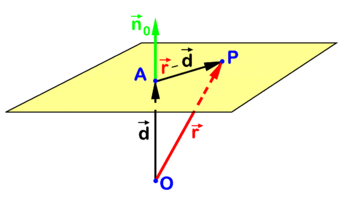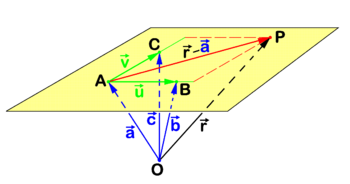Point-normal representation

PD Image Fig. 1. Equation for plane. X is arbitary point in plane;  and
and  are collinear.
are collinear. In analytic geometry several closely related algebraic equations are known for a plane in three-dimensional Euclidean space. One such equation is illustrated in figure 1. Point P is an arbitrary point in the plane and O (the origin) is outside the plane. The point A in the plane is chosen such that vector

is orthogonal to the plane. The collinear vector

is a unit (length 1) vector normal (perpendicular) to the plane which is known as the normal of the plane in point A. Note that d is the distance of O to the plane. The following relation holds for an arbitrary point P in the plane

This equation for the plane can be rewritten in terms of coordinates with respect to a Cartesian frame with origin in O. Dropping arrows for component vectors (real triplets) that are written bold, we find

with

and

Conversely, given the following equation for a plane

it is easy to derive the same equation.
Write

It follows that

Hence we find the same equation,

where f , d, and n0 are collinear. The equation may also be written in the following mnemonically convenient form

which is the equation for a plane through a point A perpendicular to  .
.
Three point representation

PD Image Fig. 2. Plane through points A, B, and C. Figure 2 shows a plane that by definition passes through the points A, B, and C. The point P is an arbitrary point in the plane and the reference point O is not in the plane. Referring to figure 2 we introduce the following definitions

Clearly the following two non-collinear vectors belong to the plane

Any vector in the plane can be written as a linear combination of these two vectors. In particular,

The real numbers λ and μ specify the direction of  . Hence the equation for the position vector
. Hence the equation for the position vector  of the arbitrary point P in the plane
of the arbitrary point P in the plane

is known as the point-direction representation of the plane. This representation is equal to the three-point representation























